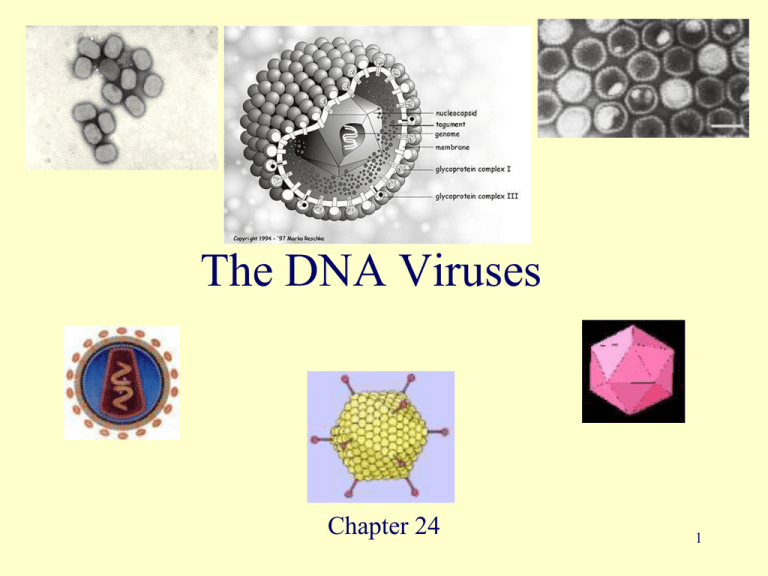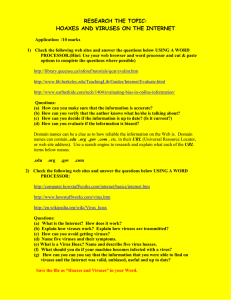Present 11
advertisement

The DNA Viruses Chapter 24 1 General Features of Viruses • • • • • • Obligate Intracellular Parasites Very small (ultramicroscopic) Non-cellular Not Alive Protein Coat (capsid) Some have envelopes 2 3 Viruses • obligate intracellular parasites • infect animals, plants, & other microbes, etc. - all forms of life have viruses that infect them • All DNA viruses are double-stranded except for parvoviruses, which have ssDNA. • All RNA viruses are single-stranded except for dsRNA reoviruses. • Viruses are limited to a particular host or cell type. (Host Range) 4 Viruses • Viral infections range from very mild and self-limiting to life-threatening. • Many viruses are strictly human in origin, others are zoonoses, some transmitted by vectors. • Most DNA & a few RNA viruses can become permanent resident of the host cell. • Several viruses can cross the placenta & cause developmental problems. 5 6 Poxviruses • produce eruptive skin pustules called pocks or pox, that leave scars • largest & most complex animal viruses • have the largest genome of all viruses • dsDNA….enveloped • examples – Variola – cause of smallpox – Vaccinia – closely related virus used in vaccines – Monkeypox – Cowpox 7 Smallpox • first disease to be eliminated by vaccination • exposure through inhalation or skin contact • infection associated with fever, malaise, prostration, & a rash – Variola major – highly virulent, caused toxemia, shock, & intravascular coagulation – Variola minor –less virulent • routine vaccination ended in US in 1972 • vaccine reintroduced in 2002 (bioterrorism threat) 8 Smallpox 9 Statue of Edward Jenner Showing Jenner transferring pus from the hands of someone infected with cowpox into Edward Jenner scratches in skin of a young boy • COWPOX • People can catch cowpox by direct contact with an infected animal and they then go on to develop pustules, on their hands. • These are quite painful and there is a general feeling of being unwell. The incubation period is about 1 week and the illness lasts about 4-6 weeks. There is a full recovery. • It had always been noticed in rural communities that dairy maids who caught cowpox would never get smallpox- they were immune. • Jenner rubbed cowpox pus into scratches of a rural farmboy (James Phipps) who then got cowpox. Jenner challenged with smallpox , but the boy did not get smallpox 10 Molluscum contagiosum • • • • • caused by an unclassified poxvirus in endemic areas it is primarily an infection of children transmitted by direct contact & fomites in US, most commonly an STD AIDS patients suffer an atypical form which attacks the skin of the face & forms tumorlike growths • treatment: freezing, electric cautery, chemical agents 11 Herpesviridae • Large, enveloped, icosahedral (20-sided polyhedron), dsDNA • large family of viruses; 8 infect humans – – – – – – – – HSV-1 HSV-2 VZV CMV EBV HHV-6 HHV-7 HHV-8 12 Herpesviruses 13 Herpesviridae • latency & recurrent infections • “Herpes is Forever” • complications of latency & recurrent infections become more severe with age, cancer chemotherapy, etc • Among the most common & serious opportunists among AIDS patients 14 Herpes Simplex viruses • HSV-1- lesions on the oropharynx, cold sores, fever blisters – occurs in early childhood • HSV-2 lesions on the genitalia – can be spread without visible lesions • humans only reservoir • treatment: acyclovir, famciclovir, valacyclovir 15 Herpes Simplex Virus-1 Latency in trigeminal nerve ganglion 16 HSV-1 gingivostomatitis 17 HSV-2 18 Varicella-Zoster Virus (VZV) • • • • • causes chickenpox & shingles transmitted by respiratory droplets & contact primary infection – chickenpox – vesicles virus enters neurons & remains latent later, reactivation of the virus results in shingles with vesicles localized to distinctive areas, dermatomes • treatment : acyclovir, famciclovir, interferon • live attenuated vaccine 19 Early symptoms are acute pain and redness of dermatome followed by rash Chickenpox Shingles 20 VZV Latency and Reactivation VZV Latency and Reactivation VZV Latency and Reactivation Cytomegalovirus (CMV) • produce giant cells • transmitted in saliva, respiratory mucus, milk, urine, semen, cervical secretions & feces • commonly latent in various tissues • most infections are asymptomatic • Almost all people have been exposed to CMV by the time they reach adulthood. • 3 groups develop a more virulent form of disease: fetuses, newborns, immunodeficient adults Giant cell 24 CMV • newborns may exhibit enlarged liver & spleen, jaundice, capillary bleeding, microcephaly, & ocular inflammation, may be fatal – Babies who survive develop neurological sequelae; hearing, visual disturbances & mental retardation • perinatal CMV infection – mostly asymptomatic, or pneumonitis, & a mononucleosis-like syndrome • AIDS patients – CMV mononucleosis, disseminated CMV, retinitis, • transplant patients - pneumonitis, hepatitis, myocarditis, meningoencephalitis 25 Epstein-Barr Virus (EBV) • infects lymphoid tissue & salivary glands • transmission – direct oral contact & contamination with saliva • by mid-life 90-95% of all people are infected. • causes mononucleosis – sore throat, high fever, cervical lymphadenopathy • Because of great sanitation in U.S. 70% of college-age Americans have never had the infection…so a very vulnerable population for mono • Long incubation period (30-50 day incubation) • most cases of infection are asymptomatic • Burkitt’s lymphoma associated with chronic coinfections with malaria, etc 26 Infectious mononucleosis (EBV) 27 Swollen tonsils and gray-white exudate Burkitt lymphoma B-lymphocyte tumor associated with chronic EBV infection 28 Diagnosis: leukocytosis with large odd lymphoctes 29 Human Herpes Virus 6 (HHV-6) • • • • • • • • • Also known as human T-lymphotropic virus transmitted by close contact with saliva, other secretions very common –95% prevalent causes roseola, an acute febrile disease in babies 2-12 months begins with fever, followed by a faint rash usually self-limited adults may get mono-like symptoms, lymphadenopathy, hepatitis over 70% of Multiple Sclerosis patients show signs of infection (Meaning of this linkage???) can cause encephalitis, cancer 30 Roseola 31 • HHV-7 is closely related to HHV-6 causes similar diseases • Kaposi’s sarcoma-associated virus or HHV8 is linked with common tumor of AIDS patients, also may be involved in multiple myeloma 32 Hepadnaviruses • enveloped DNA viruses • never been grown in tissue culture • unusual genome containing both double & single stranded DNA • tropism for liver • Hepatitis B virus causes hepatitis & can be a factor in liver cancer 33 Unusual genome Circular, with part ds DNA and part ss DNA 34 Viral hepatitis • hepatitis – an inflammatory disease of liver cells that may result from several viruses • interferes with liver’s excretion of bile pigments, bilirubin accumulates in blood & tissues causing jaundice, a yellow tinge in skin & eyes • caused by 3 principal viruses 35 36 Hepatitis B virus • multiplies exclusively in the liver, which continuously seeds blood with viruses • 107 virions/mL blood (a lot) • minute amounts of blood can transmit infection • sexually transmitted • high incidence among homosexuals & drug addicts • can become a chronic infection • increases risk of liver cancer • chronic infection controlled with interferon • HBV vaccine –given in 3 doses over 18 months 37 HBV (clinical features) 38 39 Adenoviruses • nonenveloped, ds DNA • 30 types associated with human disease • infect lymphoid tissue, respiratory & intestinal epithelia & conjunctiva • oncogenic in animals, not in humans • spread by respiratory & ocular secretions • causes colds, pharyngitis, conjunctivitis, keratoconjunctivitis, acute hemorrhagic cystitis Adenoviral pinkeye – Adenovirus is only one of many viruses that can cause “the common cold”! • vaccine available 40 Papovaviruses This term/grouping of viruses is becoming less often used • Papillomavirus • Polyomavirus • Simian vacuolating virus • small nonenveloped icosahedra (20-sided polyhedron) with dsDNA 41 Papillomavirus • papilloma – benign, squamous epithelial growth, wart or verruca • caused by 40 different strains of HPV • Common warts (seed warts) – on fingers, etc • plantar warts – on soles of feet • genital warts – prevalent STD • transmissible through direct contact or contaminated fomites, autoinnoculation (self-spread) • Incubation – 2 weeks – more than a year 42 Papillomavirus Plantar wart Common wart Genital wart 43 Genital warts • most common STD in US • over 6 M new cases each year • 30 M carriers of one of the 5 types of HPV associated with genital warts • CDC estimates sexually active people have a 50% chance of catching HPV during a lifetime • strong association with cervical & penile cancer • Vaccine available 44 HPV Vaccine • For girls and women 9-26 years of age • Three doses – Initial – 2 month booster – 6 month booster • For prevention only…not a treatment Polyomaviruses • induce tumors • JC & BK viruses (named after patients from which the viruses were first isolated) • • • • common throughout the world majority of infections are asymptomatic or mild not much is known BK infection in renal transplants causes complications in urinary function • Progressive multifocal leukoencephalopathy (PML) is an uncommon fatal infection by JC 46 Parvoviruses • nonenveloped icosahedral virus, ssDNA • very small diameter & genome size • causes distemper in cats, enteric disease in dogs, fatal cardiac infection in puppies • B19 variety causes fifth disease, (erythema infectiosum), rash of childhood – Child may have fever & rash on cheeks – Severe fatal anemia can result if pregnant woman transmits virus to fetus 47 Parvoviruses “slapped face” rash of fifth disease. 48




